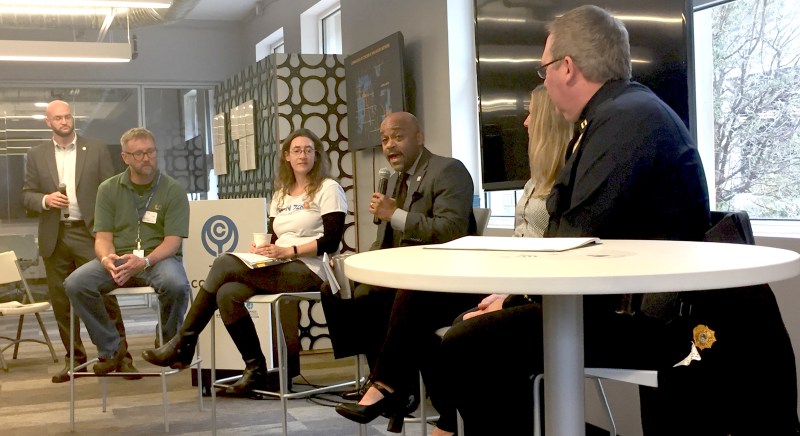Hancock Unveils Final Plan to End Traffic Deaths; City to Take “Immediate Action” on Federal Blvd, Colfax Ave

Mayor Michael Hancock presented his plan to end traffic deaths and serious injuries in Denver today. Just a few hours earlier, a driver struck and injured yet another person walking on Federal Boulevard, the city’s deadliest street.
In his remarks about the Vision Zero Action Plan [PDF], Hancock invoked the preventable death of 14-year-old Cole Sukle, who was killed by a driver while riding his skateboard in the Yale Avenue bike lane last year.
“Cole’s family deserves safe streets, and in his memory, today we move forward with Vision Zero,” Hancock said. “All of Denver deserves safe streets. Loss of life is a tragedy, but even more tragic than that loss of life is that every single one of those deaths was preventable. We must and we will do better.”
The Hancock administration released a draft Vision Zero plan this summer that expressed the moral imperative of ending preventable deaths and described the problem well, but needed a more detailed course of action.
The version released today is not much different, but there are a few significant tweaks. Notably, the map showing Denver’s most dangerous streets now highlights whether they’re owned by the Colorado Department of Transportation or the city, which should help traffic safety watchdogs hold the right officials accountable.
The revised plan also raises the bar — a little. The city says it will build 45 miles of bike lanes between 2018 and 2023 (up from 35), and lengthen walk phases and add head starts for pedestrians at 20 intersections (up from 13). Given the hundreds of miles of streets in Denver, however, the pace and scale of change should be bolder.
In a more encouraging sign, the city will be making changes to deadly Federal Boulevard right away. Crissy Fanganello, Denver’s director of transportation and mobility, said her department will take “immediate action” on Federal, a CDOT-owned street where 10 people have been killed in traffic this year alone. Six of the victims were walking. The city will be implementing safety improvements using signals and low-cost materials at eight intersections in the next few weeks.
“Certainly the number of crashes and injuries and deaths that have been happening is starting to elevate that work even more, but it was already pretty high on the list of things we had to work on,” Fanganello said.
Here’s what’s in the works on Federal:
- Signal phases that give people more time to cross Federal at Kentucky, 10th Avenue, Howard Place/14th Avenue, and Holden Place. Pedestrians will also get a head start on drivers, so they can establish themselves in the crosswalk before motorists try to turn across their path.
- The city will make the same changes at four yet-to-be-identified intersections between Virginia and Jewell Avenues, and will add pedestrian countdown indicators.
Look for these changes at the dangerous intersection Colfax Avenue, Park Avenue, and Franklin Street in the next few weeks as well:
- A turn ban preventing eastbound drivers on Colfax from taking a left onto Franklin.
- Adding median refuges to pedestrian crossings, using paint and plastic posts.
- Painted curb extensions with plastic posts to shorten crossings for pedestrians and reduce speeding.

Rapid street changes like these are a good start, and they wouldn’t be happening without the blessing of CDOT, which helped produce the action plan. That’s a good sign. But it remains to be seen whether CDOT, which has historically placed a high priority on moving motor vehicles over keeping pedestrians safe, will facilitate the major long-term changes needed to eliminate traffic deaths on its urban streets.
At the event today, I asked if CDOT would give the city free rein to reach its safety goals. “Free rein? I’m not sure I’d use that terminology,” said Jay Hendrickson, a CDOT engineer. “But we are coordinating very closely to work on solutions that meet the goal that Mayor Hancock and the Vision Zero team have laid out so eloquently, but also meet the state transportation department’s goals of mobility, safety, volume, capacity — it’s an incredibly mixed bag of different priorities that we need to achieve.”
CDOT is “working to strike that perfect balance,” Hendrickson said.
The word “balance” is often code for half-measures or inaction. Instead of prioritizing walking, biking, and transit on city streets, for instance, policy makers fit other modes in at the margins, maintain the primacy of private cars, and call it “balance.”
In the context of Vision Zero, which starts from the core premise that preventing the loss of life is a moral necessity, “balance” doesn’t make sense as a framework. On CDOT streets like Federal Boulevard, safety will have to take precedence over motor vehicle volume and capacity.
Now that the Vision Zero plan has been released, Streetsblog will follow the implementation closely and report regularly on its effectiveness.


